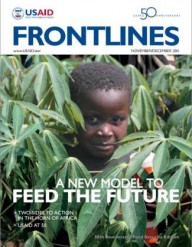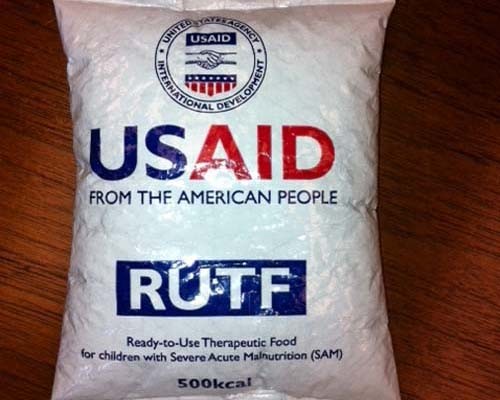 USAID foodstuffs are distributed through the World Food Program to internally displaced persons in Muhadjeria, Darfur.
William Daniels
USAID foodstuffs are distributed through the World Food Program to internally displaced persons in Muhadjeria, Darfur.
William Daniels
 USAID foodstuffs are distributed through the World Food Program to internally displaced persons in Muhadjeria, Darfur.
William Daniels
USAID foodstuffs are distributed through the World Food Program to internally displaced persons in Muhadjeria, Darfur.
William Daniels
Imagine you have just survived a major natural disaster—say an earthquake or a tsunami. You have no food or water, much less shelter or a stove. What do you do? Do you wait for help to come? Do you start walking to find safe ground? Do you have to worry about getting sick?
Now imagine you live in an area that is chronically food insecure—the equivalent of a daily disaster—where you and your child do not get enough to eat. To make matters more difficult, the nearest market is miles away and you have no transportation.
USAID is addressing both of these scenarios by bringing a variety of food products to people in emergency and chronically food-insecure situations. The Agency aims to improve nutrition in targeted populations through more effective use of existing and new food products.
A major driver behind this effort has been an extensive review of the quality of U.S. food aid. In spring 2011, USAID and the Tufts University Friedman School of Nutrition Science and Policy released recommendations from this two-year Food Aid Quality Review, which outlined concrete ways the Agency and the U.S. Department of Agriculture can enhance the impact of U.S. food assistance.
Researchers looked at recent food crises around the globe and consulted with a wide variety of partner organizations with long histories of delivering food in the developing world. The review investigated the nutritional needs of vulnerable populations, especially children, as well as the ability of current food-aid products to meet those needs. A good deal of nutrition research over the past several years has focused on a critical period of 1,000 days, before the age of 2, when the right nutrition can play a huge role in a child’s growth and development.
“One of the challenges was to determine a range of appropriate products to meet a variety of programmatic, as well as beneficiary, needs; products that would do a better job of delivering currently-defined macronutrient and micronutrient requirements to children under 2, as well as being viable for treating or preventing moderate wasting in children under 5, and for meeting the needs of individuals wasted due to AIDS,” said Patrick Webb, dean for academic affairs of the Friedman School of Nutrition Science and Policy at Tufts University.
Finding the Right Blend
10 Steps for Developing New Food Products
- Identify the specific nutritional needs of food-assistance beneficiaries.
- Apply the latest nutrition science to determine the best combination of nutrients and products to meet those needs.
- Translate this science into practical application—through work with industry on a pilot scale to produce products.
- Conduct accelerated storage studies (i.e., shelf life testing), to ensure product will last.
- Identify whether current industrial capabilities exist to produce the product.
- Once pilot trials are complete, have industry partners scale up their trials to a full commercial run.
- Field-test the product with an implementing partner (preferably in two different field contexts).
- Modify the product or programming based on lessons learned from the field tests.
- Produce the final specifications, write any programming guidance, and then add the product onto the Food for Peace commodity items list.
- Products are then available for use by private voluntary organizations and international public organizations in their emergency and development food assistance programs.
Among many recommendations, the report suggests reformulating corn-soya blend, a highly fortified specialty product used to fight malnutrition. The new formula would add dairy protein and improve the vitamins and minerals to make it better suited as a complementary food for older, breastfeeding infants and young children. Other recommendations include adding vitamin D to vegetable oil, which is currently only fortified with vitamin A; enhancing the fortification of milled flours and corn meal; adding ready-to-use products when needed and appropriate; and modifying the guidance that USAID provides to its implementing partners to help them choose the right product for the right purpose.
According to Stephen Moody, a senior adviser for food technology at USAID, “ These recommendations could result in the most far-reaching nutritional improvements to U.S. food aid since the introduction of fortified blended foods in 1966.”
The increased focus on better nutrition for children under 2 years old will have a measurable and positive impact on their quality of life and human potential for the rest of their lives. This was documented, among other places, in a series of articles on maternal and child nutrition published in the British medical journal The Lancet in 2008. The Lancet series challenged the international community to better serve those most needy and vulnerable groups. “The USAID Food Aid Quality Review makes recommendations to help meet that challenge,” says Moody. This fall, USAID will begin to implement some of the product improvements, working closely with USDA and industrial partners to ensure the new products are cost-effective and practical to produce. Strengthening existing products and using them in new ways is just the first step in broadening USAID’s options for humanitarian food assistance.
Ready to Use
In August, USDA awarded contracts to three U.S.-based companies to produce Ready-to-Use-Therapeutic Food (RUTF). RUTF is a product specifically formulated for community-based treatment of severe acute malnutrition in children. Historically, children with severe acute malnutrition have had to go to a hospital or clinic and receive a therapeutic milk product under safe and sanitary conditions.
With RUTF, as long as the malnourished children have an appetite, families or caregivers can treat them at home. This not only relieves cost and burden from the health-care system, but allows children to remain in a more familiar and comfortable environment with their families.
USAID is exploring ways to put the U.S.-produced RUTF to use immediately.
Similar to RUTF, emergency food bars are another product newly available to USAID. The compressed bars, similar to dense shortbread, are highly fortified and ready-to-eat. Emergency responders can use these bars as meal replacements for vulnerable populations during the initial onset of emergencies when other humanitarian food assistance is not available. The bars are designed for any age group and do not need preparation or cooking, so they are ideally suited to prevent malnutrition in populations that are displaced due to conflict or natural disaster until they can reach a place where more traditional food assistance—things like cereals, legumes, and vegetable oil—can be provided.
The emergency food bars, and eventually an emergency meal replacement spread, will be stored in strategic locations where they will be ready for an immediate response during a disaster, such as the recent floods in Pakistan or the 2010 Haiti earthquake. When items such as these were distributed, food aid organizations were able to meet the immediate food needs of populations in 24 to 48 hours of the disaster.
An additional product USAID has been using in the last year to improve nutrition is a supplement called Nutributter. One 20-gram packet of Nutributter (technically referred to as a lipid-based nutritional supplement, or LNS) has a full day’s vitamin and mineral requirements for children between ages 6 months and 24 months. The LNS is meant to complement breastfeeding by being added to foods traditionally given to very young children. Since fortified foods are often inaccessible to families in developing countries, the LNS can provide the needed nutrition during that critical 1,000-day window to promote healthy growth and development.
USAID will continue to expand its food assistance toolbox in the coming months with the addition of Ready-to-Use Supplemental Food designed to treat moderate acute malnutrition and prevent severe acute malnutrition in children over 6 months old. These and other specialized products are meant to be used in a specific context to achieve explicit nutritional outcomes in targeted populations, particularly older infants and young children, as well as pregnant and lactating mothers. They are not meant to replace the traditional humanitarian assistance food basket of cereals, legumes, and vegetable oil. The new and improved products are used to target very specific needs of particularly vulnerable groups such as older infants and young children, while the traditional mix of cereals, legumes, and vegetable oil are used for blanket feeding of larger populations threatened by poverty and food insecurity.
Providing emergency food assistance that meets the nutritional requirements of vulnerable populations is a consideration when responding to food needs. For example, in responding to the Horn of Africa crisis, USAID has been working to ensure that enough grains, legumes, and vegetable oil are available to support drought-relief operations.
Through cooperation with the USDA Farm Services Agency, USAID has also identified additional sources of highly nutritious, fortified blended foods to help prevent malnutrition in older infants, young children, and pregnant and lactating women. In addition, USAID hopes shortly to be able to use the new ready-to-use products in the Horn.
For more than 50 years, USAID has been at the forefront of providing humanitarian food assistance in response to emergencies. “By applying the latest in nutrition science to food aid products and programming, the Agency will continue to save lives and make an even greater impact in combating undernutrition in the world’s most vulnerable populations,” says Dina Esposito, director of USAID’s Office of Food for Peace.










Comment
Make a general inquiry or suggest an improvement.